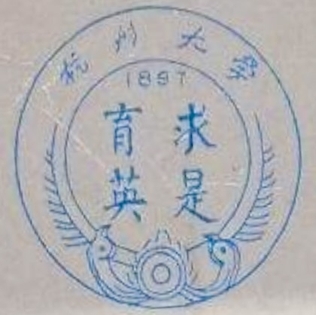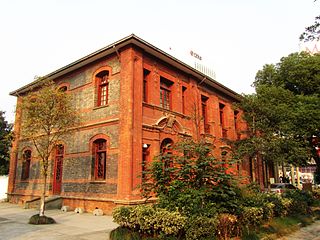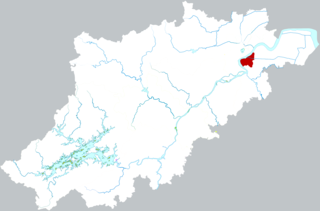Related Research Articles

Hangzhou is the capital city of the Chinese province of Zhejiang. It is located in the northeastern part of the province, sitting at the head of Hangzhou Bay, which separates Shanghai and Ningbo.

Zhejiang University (ZJU) is a public university in Hangzhou, Zhejiang, China. It is affiliated with the Ministry of Education. The university is part of Double First-Class Construction, Project 985, and Project 211.

The West Lake is a freshwater lake in Hangzhou, China. Situated to the west of Hangzhou's former walled city, the lake has a surface area of 6.39 km2 (2.47 sq mi), stretching 3.2 km (2.0 mi) from north to south and 2.8 km (1.7 mi) from east to west. In the lake are four causeways, three artificial islands, and the Gushan, the only natural island. Gentle hills surround the lake on its north, west, and south sides, with the Leifeng and Baochu pagodas standing in pair on the south and north banks. Several famous temples are nestled in the mountains west of the lake, including the temples of Lingying and Jingci.

Queenstown is a planning area and satellite residential town situated on the south-westernmost fringe of the Central Region of Singapore. It borders Bukit Timah to the north, Tanglin to the northeast, Bukit Merah to the east and southeast, as well as Clementi to the northwest and west. Its southern and southwesternmost limits are bounded by the Pandan Strait.

Hangzhou University was a public university in Hangzhou, Zhejiang, China. The institute was merged into Zhejiang University in 1998.

The Second Affiliated Hospital of Zhejiang University School of Medicine, known as Kwang Chi Hospital before 1952, is a non-for-profit tertiary care public hospital in Hangzhou, Zhejiang, China. Founded as a drug rehabilitation clinic in 1869 by the British Church Missionary Society, it is one of the oldest hospitals in Zhejiang to offer Western medicine and one of the leading medical centres in China.

Hubin Campus, was an urban campus of the Zhejiang University. It was the campus of Zhejiang Medical University before it was merged into Zhejiang University in 1998.

Zhijiang Campus is an urban campus of Zhejiang University located in Hangzhou, Zhejiang, China. Located on riverside of the Qiantang River and close to the Liuhe Pagoda, it was the oldest university campus in Hangzhou. Built as the campus of Hangchow University, one of the oldest Christian colleges and universities in China, most of its buildings are protected as the Hangchow University Historic Site under the list of Major Sites Protected at the National Level. The campus is now home to James D. Watson Institute of Genome Sciences, Guanghua Law School and the Institute for Advanced Study in Humanities and Social Sciences.

The former site of Qiushi Academy is historic site protected as a Major Historical and Cultural Site Protected at the National Level. The site was made a college campus by Hangzhou mayor Lin Qi in 1897. It became the oldest campus of Zhejiang University and hosted the university until it moved to Yuquan campus in 1956.

is one of ten urban districts of the prefecture-level city of Hangzhou, the capital of Zhejiang Province, in East China, it is located in the core urban area of Hangzhou. It is across the Qiantang River from West Lake and the older parts of Hangzhou. Like Pudong in Shanghai, it a very modern, and rapidly developing, area that was mostly farmland until ten years ago. The district's total area is 72.2 square kilometres (27.9 sq mi), and its permanent population totals 503,859 people as of 2020. The district people's government is situated on Xixing Road.
Hangzhou historic houses are artifacts, buildings, or districts in Hangzhou, China, which have been legally declared to be "protected". According to the "Regulations of historic districts and historic buildings in Hangzhou" effectivated from 1 January 2005, historic buildings are those artifacts or districts that have lasted more than 50 years, and are of significant value for history, science, and art. In Hangzhou, declaring a historic house requires consulting the urban planning administration bureau, and the real estate administration bureau.
The following is a timeline of the history of the city of Hangzhou, Zhejiang Province, China.

Zhejiang University–University of Edinburgh Institute is an affiliated school of Zhejiang University, located in Haining, Zhejiang, China. The school does not have independent legal personality. It was established in 2015 under partnership with the University of Edinburgh.
19 Jinchaidai Alley, in Shangcheng District, Hangzhou, Zhejiang, China, is a former residence constructed during the Qing dynasty, which was used during the Xinhai Revolution that led to the dynasty's collapse. Despite concerns over its historical significance, the building began to be demolished in 2010 despite its addition to the fifth batch of protected historical buildings in Hangzhou earlier that year, although its demolition was stopped by the city government's intervention. The building has now been renovated, and serves as part of the campus of the Jianlan Middle School's Lanxin Academy of Classical Learning, a private school in the city.

The Former Residence of Chiang Ching-kuo is a wood and brick western-style villa on the north shore of the West Lake in Hangzhou, China. After the World War 2, the villa was once made the home of Chiang Ching-kuo, who later became the president of Republic of China in Taiwan, and his wife Chiang Fang-liang before they fled to Taiwan in 1949. The villa, echoing the Chenglu villa of his father Chiang Kai-shek and stepmother Soong Mei-ling on the south shore of the Inner West Lake, has also served as home to several important figures in the Chinese history, including Li Shiqun, Huang Yuan, Chen Jiangong, Feng Baiju. Currently, the residence is protected as a provincial historic site, though a McDonald's and a Starbucks operate within the villa since 2015 which has led to controversy.

Ocean College is a college under Faculty of Engineering of Zhejiang University (ZJU). Located on the Zhoushan Island, it was the first ZJU institution outside of Hangzhou. The college participated in several national ocean science projects, including the development of Jiaolong submersible. The college offers both undergraduate and postgraduate education, but undergraduates of the college will study at Zijingang campus for the first two years. The colleges offers courses in marine biology, oceanography, underwater technology and offshore engineering.
References
- ↑ Wufu Alley Building Cluster
- ↑ Jiuxing Alley Building Cluster
- ↑ Villa at 147, Jianguo Road (S)
- ↑ 290 to 298 (Even Numbers), West Lake Avenue
- ↑ 224 to 236 (Even Numbers), West Lake Avenue
- ↑ The Building at 26, Liangdaoshan Road
- ↑ The Building at 52, Youdian Road
- ↑ The Building at 8, Youdian Road
- ↑ The Building at No.2, Renhe Road
- ↑ The Building at 1, By West River
- ↑ Contemporary Building Cluster by Qingbo River
- ↑ Contemporary Building Cluster at Guangfuli Street
- ↑ The Building at 47, Shiwukui Alley
- ↑ Xiaoputuo building by Wu Hill
- ↑ The Building at 34, Guozinong Alley
- ↑ The Building cluster at 10, 11 and 21, Second Alley, Jiangbian Road
- ↑ The Building at 1, Alley 178, Nanshan Road
- ↑ Building Cluster at 57 through 59, Dajing Alley
- ↑ Shao Zhiyan Writing Brush Store
- ↑ The Building at 19, Jueyuan Temple Alley
- ↑ The Building at Zhugan Alley Community
- ↑ Hangzhou Gymnasium
- ↑ The Building Cluster at No.24, Dengxin Alley
- ↑ The Building at 1, Jiaochang Road
- ↑ The Building at 12, Rende Alley
- ↑ The Complex of Hangzhou Electronic Science and Technology University
- ↑ The Complex of Yuquan Campus, Zhejiang University
- ↑ The Complex of Xixi Campus, Zhejiang University
- ↑ The Complex of School of Life Science, Xi’xi Campus, Zhejiang University
- ↑ The Complex of Zhejiang Communist Youth League of China|Communist Youth League School
- ↑ The Complex of Zhejiang Education Institute
- ↑ Main Building of Hangzhou Hotel
- ↑ 3 Building of the Worker’s Sanatorium, Zhejiang Federation of Trade Unions
- ↑ 1 Building of Liu’s Villa
- ↑ The Building Cluster of Wang’s Villa
- ↑ The Villa at 97, Beishan Road
- ↑ The Villa at 4, Lingyin Road
- ↑ The Villa at 10, Lingyin Road
- ↑ The Villa at 11, Lingyin Road
- ↑ The Villa Cluster at Shengtang Road
- ↑ Shihan Villa
- ↑ The Complex of Mituo Temple
- ↑ Huai Villa
- ↑ The Complex of the Former Site of Jianqiao Aviation School
- ↑ The Complex of Huajiachi Campus, Zhejiang University